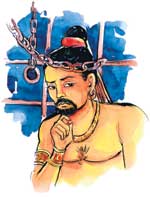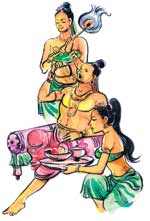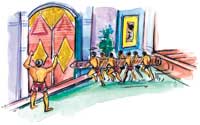| This
article is part of a continuing series on the 'Mahavamsa,'
the recorded chronicle of Sri Lankan history
Hindu influence
By Halaliye Karunathilake
Edited and translated by Kamala Silva
Illustrated by Saman Kalubowila
King Kashyapa 1 made Sigiriya his
capital. As a result, for a period of about eight years,
Anuradhapura was not the capital city. But Mugalan,
who came to the throne next, made Anuradhapura the capital
once more. From that time till 1017, no ruler wanted
to change the capital. The invaders however, did not
like Anuradhapura. They broke down and destroyed the
temples there and plundered all the wealth. They ruined
the city, abandoned it and made Polonnaruwa, the next
capital. They named it Jayanathapura.
 It
became a part of the Chola empire. These foreigners
were not Buddhists. They were Hindus. One aim of King
Raja Raja was to conquer countries and spread Hinduism.
In Sri Lanka too, the Cholas tried to achieve this ambition.
By this time, there were people who had been followers
of Hinduism for generations. One thing they lacked badly
was administrative powers. Some of them were wealthy
and held high office under the king. It
became a part of the Chola empire. These foreigners
were not Buddhists. They were Hindus. One aim of King
Raja Raja was to conquer countries and spread Hinduism.
In Sri Lanka too, the Cholas tried to achieve this ambition.
By this time, there were people who had been followers
of Hinduism for generations. One thing they lacked badly
was administrative powers. Some of them were wealthy
and held high office under the king.
Hinduism in Sri Lanka, has a longer history than Buddhism.
During the period before King Devanampiyatissa, Hinduism
flourished here. King Pandukabhaya, who made Anuradhapura
the capital city, was also a follower of Hinduism. The
kings, who were engaged in the struggle for power to
ascend the throne, brought in Tamil soldiers. Some of
them never went back. They settled down here. There
were a lot of people who descended from these Tamil
soldiers. They set up villages here.
Almost all of them were Hindus. They built Hindu devales
and for some of these the Sinhala kings too helped.
Many kings had been in the practice of getting Hindu
religious ceremonies like Yaga, performed. With all
this, they were not as powerful as the Buddhists. But
with the spread of Chola power, Hindus became very powerful
and the Buddhists were cornered. The Chola rulers made
the devale the most important centre. The high place
the temple occupied, all these years, was taken by the
Hindu religious centres. Buddhist temples were neglected.
 They
started building new devales, even on temple grounds.
With this came Hindu influence, on our art and architecture.
The 'Shiva Devale' of Polonnaruwa is one of them. Most
of the gods and goddesses respected in Hinduism, influenced
Sri Lankans. They also started worshipping gods like
Vishnu. Shiva, Ganesh and Murugan and goddesses like
Luxhmi, Durga and Pattini. It did not take long for
the belief in these gods to spread here. They
started building new devales, even on temple grounds.
With this came Hindu influence, on our art and architecture.
The 'Shiva Devale' of Polonnaruwa is one of them. Most
of the gods and goddesses respected in Hinduism, influenced
Sri Lankans. They also started worshipping gods like
Vishnu. Shiva, Ganesh and Murugan and goddesses like
Luxhmi, Durga and Pattini. It did not take long for
the belief in these gods to spread here.
The Buddhists embraced the worship
of these gods. They publicly performed poojas for these
gods. The Hindu priests who were Brahmins, did not follow
the simple life style of the Buddhist priests. They
were used to enjoying the luxuries of life. Moreover,
they believed in the caste system. They led household
lives, got married and had children, who also became
Brahmin priests. They learnt from the Vedas and the
Vedantas.
 Hinduism
is in the Sanskrit language and Sanskrit spread in Sri
Lanka. Due to all this influence of Hinduism, very soon,
the power of the Sinhala people decreased in Pihiti
Rata. It came under Chola rule. The Cholas oppressed
the Sinhala people and collected taxes. The poor became
poorer and the Cholas on the other hand did all they
could to stabilize their power. They even erected a
fortress. Hinduism
is in the Sanskrit language and Sanskrit spread in Sri
Lanka. Due to all this influence of Hinduism, very soon,
the power of the Sinhala people decreased in Pihiti
Rata. It came under Chola rule. The Cholas oppressed
the Sinhala people and collected taxes. The poor became
poorer and the Cholas on the other hand did all they
could to stabilize their power. They even erected a
fortress.
This fort was built in a place called
'Rakpankata' in Polonnaruwa. From here, they wanted
to spread their influence not only in Malaya Rata and
Maya Rata but also in Ruhuna. The Sinhala people in
Pihiti Rata who could not tolerate Chola oppression,
left their villages and fled to the Ruhuna. The people
in Ruhuna were sad to hear of the suffering they underwent.
They began to hate the Cholas.
|
